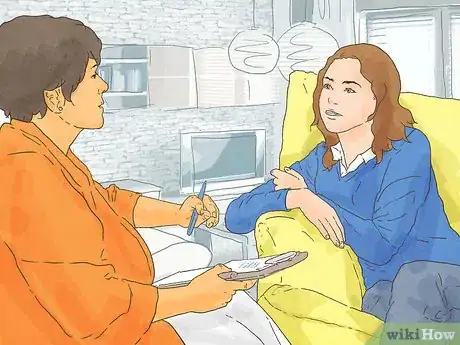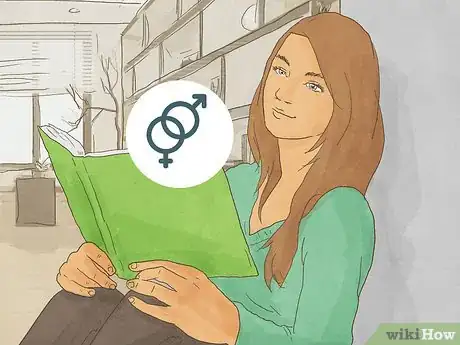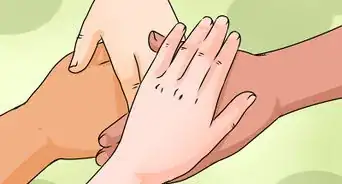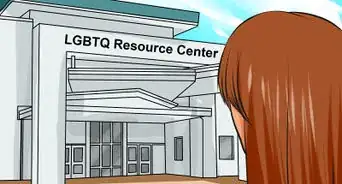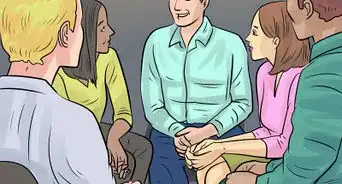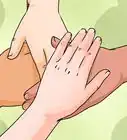This article was co-authored by Samantha Fox, MS, LMFT and by wikiHow staff writer, Megaera Lorenz, PhD. Samantha Fox is a Marriage & Family Therapist in private practice in New York, New York. With over a decade of experience, Samantha specializes in relationship, sexuality, identity, and family conflicts. She also advises on life transitions for individuals, couples, and families. She holds both a Master’s degree and a Marriage and Family Therapy License. Samantha is trained in Internal Family Systems (IFS), Accelerated Experiential Dynamic Psychotherapy (AEDP), Emotion Focused Couples Therapy (EFT), and Narrative Therapy.
This article has been viewed 503,334 times.
Human sexuality is determined by a complicated mix of biological, psychological, and environmental factors. Medical experts believe that you can’t choose your sexual orientation—it’s just a part of who you are. While some people have a clear understanding of their sexual identity from a very early age, figuring out your sexuality can be a lifelong process. It is normal to have questions about your own sexual orientation. If you are not sure whether you are heterosexual (straight), it can help to explore your feelings, talk to someone you trust (like a teacher, counselor, family member, or friend), and educate yourself about different aspects of sexual orientation and identity.
Steps
Exploring Your Feelings
-
1Determine whether you feel attracted to people of the opposite gender. Even if you have never had a romantic or sexual relationship with another person, you may have had feelings of sexual or romantic attraction toward other people. Think about people you have been attracted to, whether they are people you know personally, celebrities, or even fictional characters.[1]
- If you find that all or most of the people you are/have been attracted to are of a different gender from you, there is a good chance you are straight.
-
2Figure out whether you feel comfortable dating someone of the opposite gender. Think about your close relationships with others, whether they are platonic (just friends), romantic, or sexual. Take a moment to ask yourself how you feel about those relationships, without judging or over-analyzing those feelings. Consider which relationships have felt most comfortable (safe, fulfilling, happy) to you.[2]
- Do you feel any romantic or sexual attraction toward your close friends of the opposite gender? If so, ask yourself how you would feel about dating any of those people.
- How do you feel about any romantic and sexual experiences you have had with people of the opposite gender, or with people of the same gender, if you’ve had them? Did you enjoy them and feel fulfilled by them? Make note of which relationships you feel the most positive about, and ask yourself how much the gender of the other person had to do with that feeling.
-
3Examine your friendships. Many people are most comfortable being friends with people they aren’t sexually attracted to. For example, gay men tend to make friends with women more easily than heterosexual men do, while straight men might be more comfortable hanging out with other men.[3]
- Think about your friendships. Are your relationships with people of the opposite gender often “complicated” by romantic or sexual feelings? Do you feel more comfortable being friends or hanging out casually with people of the same gender as yourself? If so, you may be heterosexual.
- Having a lot of friends of one gender or the other does not necessarily say anything about your sexuality. Look at your friendships along with other factors, like your romantic history or the types of sexual situations you like to fantasize about.
-
4Use your imagination. Picture yourself in romantic or sexual situations with people of different genders. Let your mind take you where it wants to go without overthinking things or judging yourself. Think about how you feel when you imagine these situations:[4]
- If you mainly enjoy imagining yourself with people of a different gender from yourself, you may be heterosexual.
- If you feel happy and excited when you imagine yourself exclusively in straight relationships or situations, then this may also be a sign that you are heterosexual.
-
5Imagine yourself with different sexual identities. Sexual orientation is not black and white—it exists on a continuum.[5] You may be straight, gay, or somewhere in the middle (bisexual or bicurious).[6] Some people think of themselves as straight even if they occasionally feel attracted to (or have even had relationships with) people of the same gender, and some people consider themselves gay even if they have felt some attraction to/had relationships with people of another gender. Others are not interested in sexual or romantic relationships at all, with people of any gender. These people may consider themselves asexual or aromantic.[7] What’s most important is how you think of yourself.[8]
- Try writing down, or saying to yourself out loud, “I am heterosexual,” or “I am straight.” How do you feel when you refer to yourself this way? Does it feel comfortable to you?
Talking It Out
-
1Talk to a close friend about your sexual orientation. Sometimes it can help to talk things over with someone who may be going through the same things and asking the same questions as you. Tell a friend you trust about the questions you have, and ask them about their own experiences, if they feel comfortable talking about it.
- If you know your friend is comfortable talking about their sexuality, try asking something like, “When did you first figure out that you are straight/gay/bisexual? How did you know?”
-
2Find a forum where you can talk about sexual identity issues. Look for a moderated forum where you can talk (anonymously, if you prefer) with other people who are also looking for answers about their sexuality. If you’d rather not join the discussion, just reading other people’s conversations about the topic can be helpful. Try starting with the Sexual and Gender Issues forum at PsychCentral: https://forums.psychcentral.com/sexual-gender-issues/
-
3Talk to a counselor. If your questions about your sexual identity are causing you a lot of anxiety and stress, consider making an appointment with a mental health specialist (psychologist, clinical social worker, or counselor). They may be able to help you understand your sexuality better, or point you in the direction of some helpful resources.
Educating Yourself
-
1Read books about human sexuality and sexual orientation. This can be a great way to understand your own sexuality better. If you are a teen or young adult searching for answers, you may wish to try one of these books:
- 100 Questions You’d Never Ask Your Parents: Straight Answers to Teens’ Questions About Sex, Sexuality, and Health, by Elisabeth Henderson and Nancy Armstrong, MD.
- S.E.X.: The All-You-Need-To-Know Sexuality Guide to Get You Through Your Teens and Twenties, by Heather Corinna.
-
2Explore educational websites that address sexuality issues. Organizations dedicated to researching human sexuality and providing resources relating to sexual and reproductive health often provide free educational materials on their websites. Try exploring one of these websites to learn more about sexual orientation:
- Kinsey Confidential. This site is partnered with the Kinsey Institute, an organization dedicated to researching human sexuality. Read expert answers to sexuality questions, and submit your own questions anonymously.
- Planned Parenthood. In addition to providing care and education relating to reproduction and sexual health, Planned Parenthood also provides information about sexual orientation and gender identity: https://www.plannedparenthood.org/learn/sexual-orientation-gender
- American Psychological Association. The APA website provides plenty of in-depth information about sexual orientation and gender identity: http://www.apa.org/helpcenter/sexual-orientation.aspx
-
3Take a class on sexuality. If you are in school, you may be able to sign up for a course on sexuality, or you may be able to sit in on a course at a local college. You may also be able to find free or affordable online courses about sexual identity. For example, check out the freely available online course materials for MIT’s introduction to Sexual and Gender Identities here: https://ocw.mit.edu/courses/womens-and-gender-studies/wgs-110j-sexual-and-gender-identities-spring-2016/
Expert Q&A
Did you know you can get expert answers for this article?
Unlock expert answers by supporting wikiHow
-
QuestionAm I polyro or panro? I know I'm ace, I've never felt romantically attracted to a boy, but I wouldn't mind dating one. I don't feel a need to label myself, but I'm just wondering.
 Paul Chernyak, LPCPaul Chernyak is a Licensed Professional Counselor in Chicago. He graduated from the American School of Professional Psychology in 2011.
Paul Chernyak, LPCPaul Chernyak is a Licensed Professional Counselor in Chicago. He graduated from the American School of Professional Psychology in 2011.
Licensed Professional Counselor
-
QuestionHow can I know if I'm gay?
 Samantha Fox, MS, LMFTSamantha Fox is a Marriage & Family Therapist in private practice in New York, New York. With over a decade of experience, Samantha specializes in relationship, sexuality, identity, and family conflicts. She also advises on life transitions for individuals, couples, and families. She holds both a Master’s degree and a Marriage and Family Therapy License. Samantha is trained in Internal Family Systems (IFS), Accelerated Experiential Dynamic Psychotherapy (AEDP), Emotion Focused Couples Therapy (EFT), and Narrative Therapy.
Samantha Fox, MS, LMFTSamantha Fox is a Marriage & Family Therapist in private practice in New York, New York. With over a decade of experience, Samantha specializes in relationship, sexuality, identity, and family conflicts. She also advises on life transitions for individuals, couples, and families. She holds both a Master’s degree and a Marriage and Family Therapy License. Samantha is trained in Internal Family Systems (IFS), Accelerated Experiential Dynamic Psychotherapy (AEDP), Emotion Focused Couples Therapy (EFT), and Narrative Therapy.
Relationship Therapist Sexuality exists on a continuum. If you want to know where you are on the spectrum, you may consider your attraction in areas like who you fantasize about, who you picture yourself in a relationship with, and what gender you feel more comfortable with. Work from what you feel—not what you feel is accepted by society.
Sexuality exists on a continuum. If you want to know where you are on the spectrum, you may consider your attraction in areas like who you fantasize about, who you picture yourself in a relationship with, and what gender you feel more comfortable with. Work from what you feel—not what you feel is accepted by society. -
QuestionCan I be straight if I sometimes think about having sex with other girls?
 Samantha Fox, MS, LMFTSamantha Fox is a Marriage & Family Therapist in private practice in New York, New York. With over a decade of experience, Samantha specializes in relationship, sexuality, identity, and family conflicts. She also advises on life transitions for individuals, couples, and families. She holds both a Master’s degree and a Marriage and Family Therapy License. Samantha is trained in Internal Family Systems (IFS), Accelerated Experiential Dynamic Psychotherapy (AEDP), Emotion Focused Couples Therapy (EFT), and Narrative Therapy.
Samantha Fox, MS, LMFTSamantha Fox is a Marriage & Family Therapist in private practice in New York, New York. With over a decade of experience, Samantha specializes in relationship, sexuality, identity, and family conflicts. She also advises on life transitions for individuals, couples, and families. She holds both a Master’s degree and a Marriage and Family Therapy License. Samantha is trained in Internal Family Systems (IFS), Accelerated Experiential Dynamic Psychotherapy (AEDP), Emotion Focused Couples Therapy (EFT), and Narrative Therapy.
Relationship Therapist
References
- ↑ Samantha Fox, MS, LMFT. Marriage & Family Therapist. Expert Interview. 19 January 2021.
- ↑ http://teenhealthsource.com/giso/understanding-sexual-orientation-gender-identity/
- ↑ https://www.tandfonline.com/doi/abs/10.1080/14759550701864918
- ↑ Samantha Fox, MS, LMFT. Marriage & Family Therapist. Expert Interview. 19 January 2021.
- ↑ Samantha Fox, MS, LMFT. Marriage & Family Therapist. Expert Interview. 19 January 2021.
- ↑ https://www.kinseyinstitute.org/research/publications/kinsey-scale.php
- ↑ http://www.asexuality.org/?q=overview.html
- ↑ https://www.psychologytoday.com/blog/the-sexual-continuum/201309/what-does-it-mean-be-mostly-heterosexual
About This Article
To know if you’re heterosexual, try to remember who you've had romantic or sexual thoughts about. If you generally fantasize about people of the opposite gender, including people you know, celebrities, or fictional characters, there's a good chance that you're straight. You can also look at who you’re most comfortable being friends with. Heterosexual people generally spend most of their time with the same sex, because their feelings aren’t complicated by sexual or romantic thoughts. Don’t worry if you’re unsure about your sexuality, since it can take a long time to work out your sexual identity. In the meantime, you don’t need to rush into labeling yourself! For more tips from our co-author, including how to talk to someone about your sexuality, read on!







